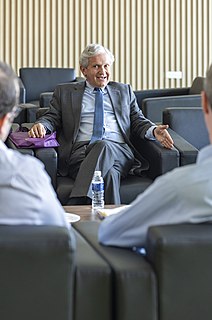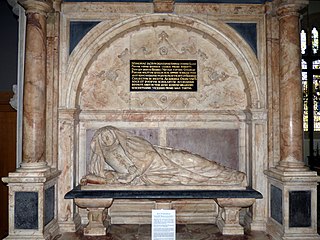Related Research Articles
Peter Stent was a seventeenth-century London printseller, who from the early 1640s until his death ran one of the biggest printmaking businesses of the day.

The Keeper or Master of the Rolls and Records of the Chancery of England, known as the Master of the Rolls, is the President of the Court of Appeal of England and Wales, Civil Division, and Head of Civil Justice. As a judge, he or she is the second in seniority in England and Wales only to the Lord Chief Justice. The position dates from at least 1286, although it is believed that the office probably existed earlier than that.

The Vice-Chamberlain of the Household is a member of the Royal Household of the Sovereign of the United Kingdom. The office-holder is usually a junior government whip in the British House of Commons ranking third or fourth after the Chief Whip and the Deputy Chief Whip. He or she is the Deputy to the Lord Chamberlain of the Household. The Vice-Chamberlain's main roles are to compile a daily private report to the Sovereign on proceedings in the House of Commons and to relay addresses from the Commons to the Sovereign and back. As a member of the Royal Household, the Vice-Chamberlain accompanies the Sovereign and Royal Household at certain diplomatic and social events, particularly the annual garden party at Buckingham Palace. When the Sovereign goes in procession to Westminster for the State Opening of Parliament, the Vice-Chamberlain stays and is "held captive" at Buckingham Palace. This custom began with the Restoration (1660), because of the previous Vice-Chamberlain's role in the beheading of Charles I.

Sir Henry Neville was an English courtier, politician and diplomat, noted for his role as ambassador to France and his unsuccessful attempts to negotiate between James I of England and the Houses of Parliament. In 2005 Neville was put forward as a candidate for the authorship of Shakespeare's works.

Dudley Carleton, 1st Viscount Dorchester was an English art collector, diplomat and Secretary of State.
Sir Henry Neville of Billingbear House, Berkshire, was a Gentleman of the Privy Chamber to King Henry VIII.

Sir Roger Townshend, 1st Baronet, was an English landowner and politician who sat in the House of Commons in two parliaments between 1621 and 1629.
New College, Durham was a university institution set up by Oliver Cromwell, to provide an alternative to the older University of Oxford and University of Cambridge. It also had the aim of bringing university education to Northern England.

The Lieutenant of the Tower of London serves directly under the Constable of the Tower. The office has been appointed at least since the 13th century. There were formerly many privileges, immunities and perquisites attached to the office. Like the Constable, the Lieutenant was usually appointed by letters patent, either for life or during the King's pleasure.

Justice of the Common Pleas was a puisne judicial position within the Court of Common Pleas of England and Wales, under the Chief Justice. The Common Pleas was the primary court of common law within England and Wales, dealing with "common" pleas. It was created out of the common law jurisdiction of the Exchequer of Pleas, with splits forming during the 1190s and the division becoming formal by the beginning of the 13th century. The court became a key part of the Westminster courts, along with the Exchequer of Pleas and the Court of King's Bench, but with the Writ of Quominus and the Statute of Westminster, both tried to extend their jurisdiction into the realm of common pleas. As a result, the courts jockeyed for power. In 1828 Henry Brougham, a Member of Parliament, complained in Parliament that as long as there were three courts unevenness was inevitable, saying that "It is not in the power of the courts, even if all were monopolies and other restrictions done away, to distribute business equally, as long as suitors are left free to choose their own tribunal", and that there would always be a favourite court, which would therefore attract the best lawyers and judges and entrench its position. The outcome was the Supreme Court of Judicature Act 1873, under which all the central courts were made part of a single Supreme Court of Judicature. Eventually the government created a High Court of Justice under Lord Coleridge by an Order in Council of 16 December 1880. At this point, the Common Pleas formally ceased to exist.
During the early part of the 17th century, and persisting in some form into the early 18th century, there were a number of proposals for an English Academy: some form of learned institution, conceived as having royal backing and a leading role in the intellectual life of the nation. Definite calls for an English Academy came in 1617, based on the Italian model dating back to the 16th century; they were followed up later, after the 1635 founding of the French Académie, by John Dryden (1664), John Evelyn (1665), and Daniel Defoe (1697).
The English College, Lisbon was a Roman Catholic seminary that existed from the 17th century to the 20th century.
English county histories, in other words historical and topographical works concerned with individual ancient counties of England, were produced by antiquarians from the late 16th century onwards. The content was variable: most focused on recording the ownership of estates and the descent of lordships of manors, thus the genealogies of county families, heraldry and other antiquarian material. In the introduction to one typical early work of this style, The Antiquities of Warwickshire published in 1656, the author William Dugdale writes:
I offer unto you my noble countriemen, as the most proper persons to whom it can be presented wherein you will see very much of your worthy ancestors, to whose memory I have erected it as a monumentall pillar and to shew in what honour they lived in those flourishing ages past. In this kind, or not much different, have divers persons in forrein parts very learnedly written; some whereof I have noted in my preface: and I could wish that there were more that would adventure in the like manner for the rest of the counties of this nation, considering how acceptable those are, which others have already performed
Eastman's Royal Naval Academy, originally in Southsea and later at Winchester, both in England, was a preparatory school. Between 1855 and 1923 it was known primarily as a school that prepared boys for entry to the Royal Navy. Thereafter, it was renamed Eastman's Preparatory School and continued until the 1940s. According to Jonathan Betts, it was "considered one of the top schools for boys intended for the Navy".

Elizabeth Bacon was an English aristocrat. She is presumed to have been the Lady Neville of My Ladye Nevells Booke, an important manuscript of keyboard music by William Byrd, which was compiled in 1591. She was the daughter of Queen Elizabeth's Lord Keeper of the Great Seal, Sir Nicholas Bacon, by his first wife, Jane Ferneley. She was, successively, the wife of Sir Robert Doyley, the courtier Sir Henry Neville, and the judge Sir William Peryam.
References
- 1 2 3 . Dictionary of National Biography . London: Smith, Elder & Co. 1885–1900.
- 1 2 Larminie, Vivienne. "Croke, Charles". Oxford Dictionary of National Biography (online ed.). Oxford University Press. doi:10.1093/ref:odnb/6730.(Subscription or UK public library membership required.)
- ↑ Brown, Mark N. "Savile, George". Oxford Dictionary of National Biography (online ed.). Oxford University Press. doi:10.1093/ref:odnb/24735.(Subscription or UK public library membership required.)
- ↑ Handley, Stuart. "Bertie, Charles". Oxford Dictionary of National Biography (online ed.). Oxford University Press. doi:10.1093/ref:odnb/65785.(Subscription or UK public library membership required.)
- ↑ Strachan, Michael. "Terry, Edward". Oxford Dictionary of National Biography (online ed.). Oxford University Press. doi:10.1093/ref:odnb/27148.(Subscription or UK public library membership required.)
- Attribution
![]() This article incorporates text from a publication now in the public domain : "Croke, John (1553-1620)". Dictionary of National Biography . London: Smith, Elder & Co. 1885–1900.
This article incorporates text from a publication now in the public domain : "Croke, John (1553-1620)". Dictionary of National Biography . London: Smith, Elder & Co. 1885–1900.